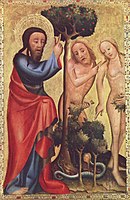
Adam and Eve
Adam and Eve, according to the creation myth[Note 1] of the Abrahamic religions,[1][2] were the first man and woman. They are central to the belief that humanity is in essence a single family, with everyone descended from a single pair of original ancestors.[3] They also provide the basis for the doctrines of the fall of man and original sin, which are important beliefs in Christianity, although not held in Judaism or Islam.[4]
This article is about the first man and woman in the Abrahamic religions. For the figures themselves, see Adam and Eve. For other uses, see Adam and Eve (disambiguation).
In the Book of Genesis of the Hebrew Bible, chapters one through five, there are two creation narratives with two distinct perspectives. In the first, Adam and Eve are not named. Instead, God created humankind in God's image and instructed them to multiply and to be stewards over everything else that God had made. In the second narrative, God fashions Adam from dust and places him in the Garden of Eden. Adam is told that he can eat freely of all the trees in the garden, except for a tree of the knowledge of good and evil. Subsequently, Eve is created from one of Adam's ribs to be his companion. They are innocent and unembarrassed about their nakedness. However, a serpent convinces Eve to eat fruit from the forbidden tree, and she gives some of the fruit to Adam. These acts not only give them additional knowledge, but also give them the ability to conjure negative and destructive concepts such as shame and evil. God later curses the serpent and the ground. God prophetically tells the woman and the man what will be the consequences of their sin of disobeying God. Then he banishes them from the Garden of Eden.
Neither Adam nor Eve is mentioned elsewhere in the Hebrew scriptures apart from a single listing of Adam in a genealogy in 1 Chronicles 1:1,[5] suggesting that although their story came to be prefixed to the Jewish story, it has little in common with it.[6] The myth underwent extensive elaboration in later Abrahamic traditions, and it has been extensively analyzed by modern biblical scholars. Interpretations and beliefs regarding Adam and Eve and the story revolving around them vary across religions and sects; for example, the Islamic version of the story holds that Adam and Eve were equally responsible for their sins of hubris, instead of Eve being the first one to be unfaithful. The story of Adam and Eve is often depicted in art, and it has had an important influence in literature and poetry.
Textual history
The Primeval History forms the opening chapters of the Torah, the five books making up the history of the origins of Israel. This achieved something like its current form in the 5th century BCE,[48] but Genesis 1–11 shows little relationship to the rest of the Bible:[49] for example, the names of its characters and its geography – Adam (man) and Eve (life), the Land of Nod ("Wandering"), and so on – are symbolic rather than real,[50] and almost none of the persons, places and stories mentioned in it are ever met anywhere else.[50] This has led scholars to suppose that the History forms a late composition attached to Genesis and the Pentateuch to serve as an introduction.[51] Just how late is a subject for debate: at one extreme are those who see it as a product of the Hellenistic period, in which case it cannot be earlier than the first decades of the 4th century BCE;[52] on the other hand the Yahwist source has been dated by some scholars, notably John Van Seters, to the exilic pre-Persian period (the 6th century BCE) precisely because the Primeval History contains so much Babylonian influence in the form of myth.[53][Note 2] The Primeval History draws on two distinct "sources", the Priestly source and what is sometimes called the Yahwist source and sometimes simply the "non-Priestly"; for the purpose of discussing Adam and Eve in the Book of Genesis the terms "non-Priestly" and "Yahwist" can be regarded as interchangeable.[54]
Y chromosomal Adam and Mitochondrial Eve
Scientific developments within the natural sciences have shown evidence that humans, and all other living and extinct species, share a common ancestor and evolved through natural processes, over billions of years to diversify into the life forms we know today.[88][89]
In biology, the most recent common ancestors of humans, when traced back using the Y chromosome for the male lineage and mitochondrial DNA for the female lineage, are commonly called the Y-chromosomal Adam and Mitochondrial Eve, respectively. Anatomically modern humans emerged in Africa approximately 300,000 years ago.[90] The matrilineal most recent common ancestor lived around 155,000 years ago,[91][92][93][94] while the patrilineal most recent common ancestor lived around 200,000 to 300,000 years ago.[95] These do not fork from a single couple at the same epoch even though the names were borrowed from the Tanakh.[96]















